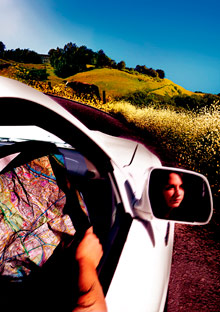The Best Kind of Journey

Photo Illustration: Caroline Shepard
U-turn! Recalculate! Keep right! Thanks to her new, slightly bossy GPS navigator, Jody Mace is on time, on track, on the straight and narrow—but at what cost, she wonders....
A few years ago, my family was exploring Provençal villages with the help of a huge, wrinkled map. The owner of the house we rented had recommended a certain restaurant in a nearby village called Cabriès. When we got to the village, we drove around in circles, unsure exactly where the restaurant was. Had we already seen that stone building or was it a different one? And where were the street signs? Finally, we called to a young man on a bicycle and pointed to the name of the restaurant on a piece of paper. We looked at him in a quizzical way that clearly indicated we were lost. He launched into rapid-fire directions, well beyond our limited grasp of French. Seeing our helpless expressions, he motioned for us to follow him. When we arrived at the restaurant—faded yellow set off with a bright red awning—he waved goodbye and coasted away. That's the last time I was lost. Since then I've bought a GPS navigator and it's kept me on track. Half the time I don't even know what street I'm on. I just obey the pleasant but authoritative feminine voice. "In .6 miles turn left."
Occasionally the navigator and I have a difference of opinion, and I ignore her advice. She corrects me. "Recalculating," she says brightly, with a crisp British accent. "Make a U-turn when possible." If I continue to go my own way, she seems to get annoyed (her voice never changes; still I detect some agitation), but she never gives up. "Recalculating. Make a U-turn now." Sometimes I turn down her volume until I'm where she wants me to be.
When I was on long car rides as a kid, I constantly asked, "When will we be there?" and the answer usually boiled down to "When we get there." When my kids ask me the same question, I can say "4:35" because the navigator keeps the estimated time of arrival on the screen. They've come to expect this level of precision. That's not to say that nothing alters the arrival time. The navigator assumes I'll be lucky with lights, there won't be any traffic, and my kids won't require bathroom breaks. When any of these events occur, the time is adjusted. "4:41." I get annoyed then, because I feel like I'm letting the navigator down. The estimated arrival time was a challenge and I'm blowing it. So I try to make up for lost time. If I go just five miles over the speed limit, every ten or 15 minutes the ETA creeps up. "4:40." "4:39."
Sometimes the roads change faster than the digital maps, and the navigator gets confused. Her screen shows me driving recklessly over fields. The arrival time jumps ahead as the navigator estimates it will take me six minutes to bushwhack through the woods back to the highway. "Recalculating," she says, devising ever more ludicrous routes to get me back on track. After my blue triangle merges onto the road on the screen, I'm relieved that the navigator and I have the same vision of the journey. We agree on where I am.



